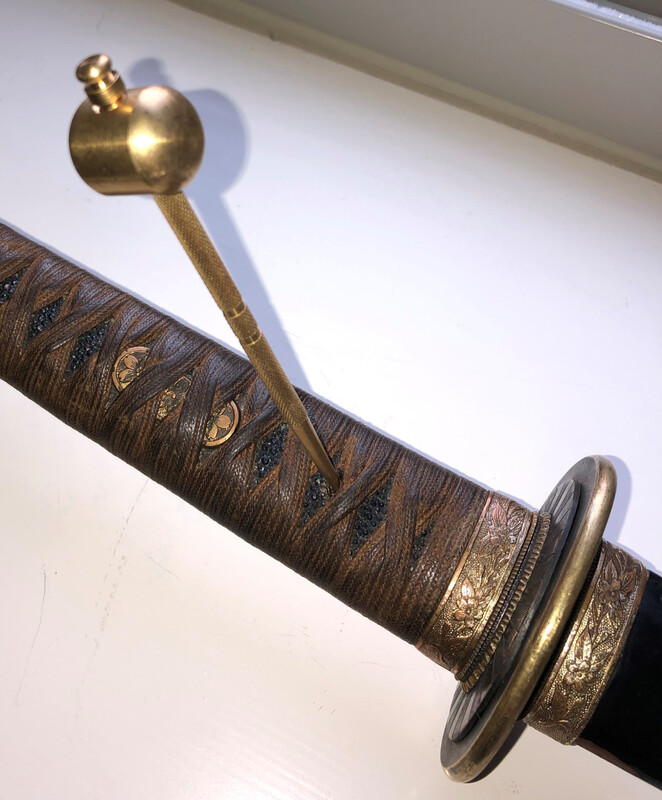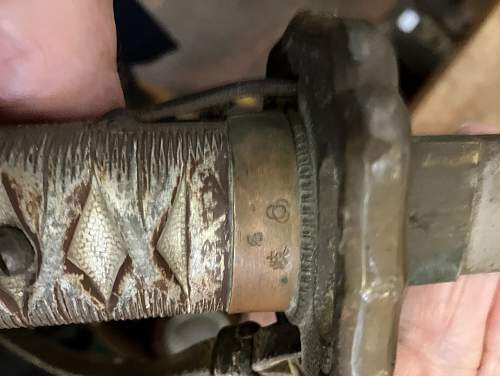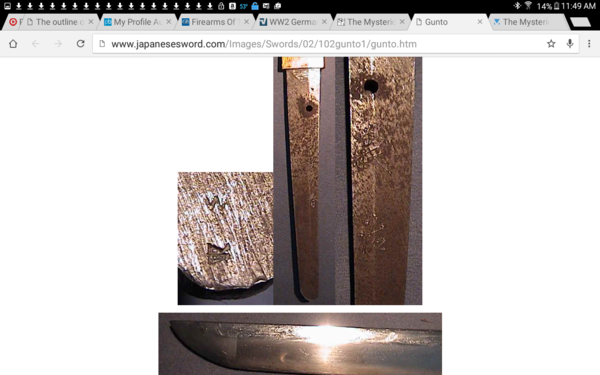-
Posts
13,526 -
Joined
-
Last visited
-
Days Won
161
Content Type
Profiles
Forums
Events
Store
Downloads
Gallery
Everything posted by Bruce Pennington
-

Tanto (Takeshima) Hisakatsu 1936
Bruce Pennington replied to Itomagoi's topic in Translation Assistance
I would also appreciate it if someone understands the significance of the image above the ana. Is it flames or a flower? Also, I see the year - 1936 - but what are the 3 kanji between that and the 8th month? -
That’s my bet too!
-

A Request for Translation ,but Please Don't Cry
Bruce Pennington replied to drac2k's topic in Translation Assistance
Somebody give Brian a chill-pill. Ha! The guy's just trying to do something fun, while preserving what is still to many of us a piece of history that represents the blood, sweat, and tears of craftsmen and soldiers. I like what David! Keep us updated. Oh, and thanks for the Seki-stamped photos for the files! Yours is only the 3rd Kanetatsu I now have on file. -

WW2 navy sword Hayakawa Yukifusa
Bruce Pennington replied to Swords's topic in General Nihonto Related Discussion
Dang. That would have been nice to have just for the black leather covered saya fittings. Quite rare in kaigunto! -

First post, first sword.. need a translation.
Bruce Pennington replied to 75Corvette's topic in Translation Assistance
I am the worst guy to answer that question! Hopefully some of the translators can help. -
Frank, welcome! Got a nice looking sword there! Yes, Type 98 Officer sword, generally speaking. You can see some examples on Ohmuras page: Informal Fittings The leather covered saya (scabbard) was made for field use. However, we need to see the bare blade. Do you know how to remove the tsuka (handle)? This could be an older family or civil blade re-mounted for the war. They are quite often fitted out this way. In either case, there are a good many of us who get our addiction fixes by seeing these blades, who made them, and various other things to be learned from the nakago (tang). It's easy to remove the handle. There is a small bamboo peg just up from the handguard (tsuba). Simply push/tap it out, and the whole handle, handguard, and spacers (seppa) slide off revealing the nakago. Don't be worried about harming anything. These swords are made for easy disassembly. Your peg can be seen here. This is probably the fatter end, and pushing it out should be tried from the other side.
-
-

First post, first sword.. need a translation.
Bruce Pennington replied to 75Corvette's topic in Translation Assistance
This will take a while, with my poor web-searching skills. Here's one with civil saya, and civil menugi, but army tsuka - Iron Civilian Gunto Tsuba Wooden saya, leather cover Remains of leather saya cover on Fully Civil sword -
Thanks Paul! I have @Markus' book on Tameshigiri, but don't see him in there (wish there was an index!) I see a page or 2 about a Masayoshi on Markus website - Signature Supplements of Satsum Masayoshi - but don't know if that's the same guy. Can we get some help with the rest of the cut test mei, guys? Is there a date? I tried, but don't see anything I recognize.
-

First post, first sword.. need a translation.
Bruce Pennington replied to 75Corvette's topic in Translation Assistance
The original fittings were not made for a leather cover. The military, when retrofitting a civil sword, would place that metal haikan (belt loop hanger) on the civil saya and then cover it with leather. The covers were custom fit to each saya. You will see (I have seen) leather covers on EVERYTHING - Kyugunto, kaigunto, Type 19s, Type 95s, wakizashi, etc. It's not restricted to any sort of sword or saya. The metal haikan on yours would not have been used without the leather cover. A good percentage of these covers go missing by the time we, as collectors, get the sword. The leather gets worn and rotten during the war and falls off, or owners, post-war, screw around with them and lose them, who knows, but it is common to see the saya with the hanger but no leather, by today. On a kyugunto (metal saya) On a kaigunto (wooden saya) with 500 yr old family blade: -

Arsenal Mark on RJT sword Fittings
Bruce Pennington replied to george trotter's topic in Military Swords of Japan
Thanks George, I might remember reading that years ago! Ha! I admit, I'm not even "Newbie" qualified to talk about mei, but I browsed a bit through my star-stamped files and here is a comparison of 2 Kanetsugu blades, and they are BOTH star-stamped. Look at the "Kane" kanji, and they're not even close. I don't see why variations, over time, in a smith's mei are surprising. People do stuff like that in real life too. Here's one on a blade with no star, and the variation is even worse: -

First post, first sword.. need a translation.
Bruce Pennington replied to 75Corvette's topic in Translation Assistance
Ok, he probably is talking about he saya (scabbard). The whole rig is civil and the saya had a knob (kurikata) that was removed for the war fittings. The metal belt loop was added and the whole thing would have been covered with leather. Many blades made during WWII were sold on the open market and made their way into civilian hands. As the war escalated, and Japan transitioned from the early Western styled swords back to traditionally designed swords, there was a tremendous shortage. The govt petitioned the populace to donate their private swords to the military, and the military even went out and paid people for their swords. These were then, in varying degrees, re-fitted for the war. Sometimes, like this one, this simply meant adding a leather saya cover with the associated metal ring. You can read about this effort on Nick Komiya's page here: Program for converting family blades and short blades into Gunto As to the blade, it has long been believed that blades receiving the Seki (or Showa) stamp were not traditionally made. Actual documentary proof of this is split 50/50. -
Paul, Could we get a photo of the nakago with the kao? I don't have a Masayoshi on file.
-

Need help authenticating a Kai-Gunto
Bruce Pennington replied to ChappyMan's topic in Military Swords of Japan
Looks like one of the late war rigs. Like you mentioned, you can see where the daiseppa used to be by the wear lines in the tsuba. -

First post, first sword.. need a translation.
Bruce Pennington replied to 75Corvette's topic in Translation Assistance
You haven’t shown us the fittings. But it was made in 1942. Can’t tell what you mean by modified fittings without seeing them. -

First post, first sword.. need a translation.
Bruce Pennington replied to 75Corvette's topic in Translation Assistance
Thanks for the great shot, Jamie! Large Seki stamp on a 1942 Kaneshige blade. The painted marks are "427", likely put there by the assembly team or shop. Some of your fittings may have the same number. The stamp means the blade passed inspection by the Seki Cutlery Manufacturers Assoc, who had the task of weeding out poor quality showato from the market. -

The Mysterious "w" Stamp!
Bruce Pennington replied to Bruce Pennington's topic in Military Swords of Japan
Sesko lists 2 Yoshiharu: YOSHIHARU (義治), Shōwa (昭和, 1926-1989), Tottori – “Yoshiharu” (義治), family name Mitani (三谷), rikugun-jumei-tōshō YOSHIHARU (義治), Heisei (平成, 1989- ), Niigata → MOTOHIRA (基平), Heisei (平成, 1989- ), Niigata Do you think our guy is neither of these? For Takehisa, Slough, pg 169 shows him from Aiichi. -

Japanese Swords Made In China During World War II
Bruce Pennington replied to Kiipu's topic in Military Swords of Japan
Well that has potential for adding to our developing discussions of blades that look like they were meant for Japanese soldiers, but with some stereotypical Chinese characteristics! -

The Mysterious "w" Stamp!
Bruce Pennington replied to Bruce Pennington's topic in Military Swords of Japan
I agree, and thanks for an actual example. I have only had the Slough reference to Haruhisa, from his Mantetsu page, pg 96, until now. -

The Mysterious "w" Stamp!
Bruce Pennington replied to Bruce Pennington's topic in Military Swords of Japan
Getting flooded. Too much information............. SO, the only confirmed smiths we have with the 'M' are: Haruhisa, Tenshin, Takehisa, and Yoshiharu. Sorry, Thomas, I know you said that, but I'm re-grouping my mind for the moment. I tried to track down prefectures for these guys and only have 2 - Takehisa: Aiichi and Yoshiharu: Tottori. Both south of Tokyo, north of Nagoya. -

First post, first sword.. need a translation.
Bruce Pennington replied to 75Corvette's topic in Translation Assistance
Jamie, welcome! How about a clear pic like that of that small stamp above the name? But after some touch-up and zoom, I see it's the large Seki. -

Arsenal Mark on RJT sword Fittings
Bruce Pennington replied to george trotter's topic in Military Swords of Japan
The difference could be due to a nakirishimei. Slough has many examples of variations due to this with other smiths. I have never seen a gimei with authentic looking "Na" stamps like this. -

The Mysterious "w" Stamp!
Bruce Pennington replied to Bruce Pennington's topic in Military Swords of Japan
Yes, a typo. I've corrected it in the Stamps Doc, thanks! Thomas, Took me a while, didn't have them documented. I think I switched the 'large Seki' on the 2 smiths. It was a Kanenori on this Wehrmacht-Awards thread. I referenced it on this Mysterious W Stamp thread. that has a very corroded large Seki, and what I still believe to be a very corroded 'W'. The debate, of course, is whether corrosion simply appears to be a Seki and W, or if an original Seki and W got badly corroded. I could see that either way, but, to me, the evidence looks like the stamps were originally there. On Kaneoto, I'm striking out. I've got Kaneoto with star, and Kaneoto with large Seki, but cannot find my reference to one with a W. But I did find a Yoshiharu with W & TO!

















